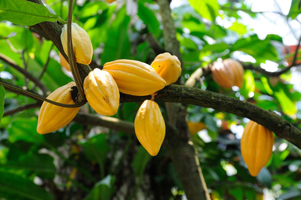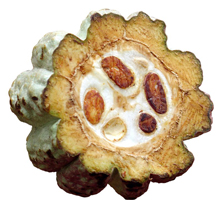|
Where does chocolate come from?Where does chocolate come from? Actually, it DOES grow on trees. It all starts with a small tropical tree, the Theobroma cacao, usually called simply, "cacao." (Pronounced ka-KOW. Theobroma is Greek for "food of the gods.") Cacao is native to Central and South America, but it is grown commercially throughout the tropics. About 70% of the world's cacao is grown in Africa.

It's actually a perfect design. The fruit attracts forest animals, like monkeys, who eat the fruit but cast the seeds aside, dispersing them and allowing new trees to sprout up. It's hard to imagine why humans ever thought to do anything with the seeds.

Next comes one of the most important steps in the process - fermentation. The beans, still sticky with pulp, are placed in earthen pits or wooden bins and covered with banana leaves, then left to ferment. The heat of fermentation changes the bitter flavors in the beans into something more edible, more chocolatey. The sugars in the bean turn into acids, the color changes from pale to dark brown, and the pulp residue melts away. The length of the fermentation process depends on the type of bean; the higher quality beans may need only a few days, where others may need a week or more. After fermentation, the beans are dried in the sun for about a week. The flavor continues to develop during this time. Some manufacturers try to speed this process along by drying the beans over a fire, which gives them a smoky, inferior flavor. Once the beans are dry, they are ready to be shipped to a factory, where they are turned into chocolate.
|






